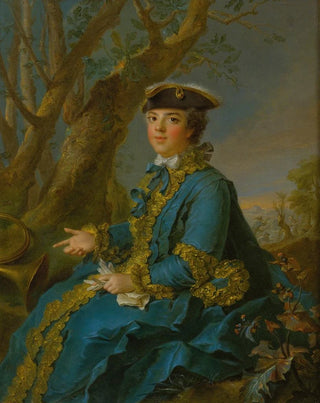Art print | Portrait of Marie Louise Élisabeth of France, Duchess of Parma - Jean-Marc Nattier


View from behind

Frame (optional)
The "Portrait of Marie Louise Élisabeth of France, Duchess of Parma" by Jean-Marc Nattier is an iconic work from the 18th century, showcasing the elegance and refinement of the French court. This painting, both intimate and majestic, depicts the duchess in all her splendor, revealing not only her beauty but also her royal status. Nattier, master of the art print, manages to capture the very essence of his subject, offering a window into the aristocracy of the time. This masterpiece invites deep contemplation, where every detail, from the choice of colors to the delicate pose, contributes to the duchess's aura.
Style and uniqueness of the work
Nattier's style is distinguished by its refined approach and his ability to incorporate elements of nature into his portraits. In this piece, the duchess is dressed in a sumptuous gown, adorned with delicate floral motifs, which seem to harmonize with the peaceful background. The pastel tones, soft and soothing, create an atmosphere of serenity, while Marie Louise Élisabeth's penetrating gaze draws the viewer in, establishing a silent dialogue. Nattier's technique, characterized by meticulous work with light and shadows, brings the canvas to life, making the figure of the duchess almost tangible. This art print stands out for its balance between realistic representation and idealization, a signature of the artist who knows how to magnify his models while respecting their essence.
The artist and his influence
Jean-Marc Nattier, a French painter of the 18th century, is often regarded as the portraitist of court women. His career is marked by a series of prestigious commissions, notably for members of the royal family and aristocracy. Nattier successfully evolved within a rapidly changing artistic context, blending influences of rococo and classicism, while developing a personal style unique to him. His ability to capture the psychology of his models, through subtle expressions and elegant poses, influenced many contemporary artists and left a lasting imprint in the art print world.

Matte finish

View from behind

Frame (optional)
The "Portrait of Marie Louise Élisabeth of France, Duchess of Parma" by Jean-Marc Nattier is an iconic work from the 18th century, showcasing the elegance and refinement of the French court. This painting, both intimate and majestic, depicts the duchess in all her splendor, revealing not only her beauty but also her royal status. Nattier, master of the art print, manages to capture the very essence of his subject, offering a window into the aristocracy of the time. This masterpiece invites deep contemplation, where every detail, from the choice of colors to the delicate pose, contributes to the duchess's aura.
Style and uniqueness of the work
Nattier's style is distinguished by its refined approach and his ability to incorporate elements of nature into his portraits. In this piece, the duchess is dressed in a sumptuous gown, adorned with delicate floral motifs, which seem to harmonize with the peaceful background. The pastel tones, soft and soothing, create an atmosphere of serenity, while Marie Louise Élisabeth's penetrating gaze draws the viewer in, establishing a silent dialogue. Nattier's technique, characterized by meticulous work with light and shadows, brings the canvas to life, making the figure of the duchess almost tangible. This art print stands out for its balance between realistic representation and idealization, a signature of the artist who knows how to magnify his models while respecting their essence.
The artist and his influence
Jean-Marc Nattier, a French painter of the 18th century, is often regarded as the portraitist of court women. His career is marked by a series of prestigious commissions, notably for members of the royal family and aristocracy. Nattier successfully evolved within a rapidly changing artistic context, blending influences of rococo and classicism, while developing a personal style unique to him. His ability to capture the psychology of his models, through subtle expressions and elegant poses, influenced many contemporary artists and left a lasting imprint in the art print world.






